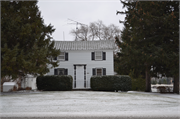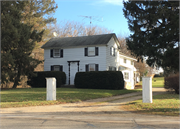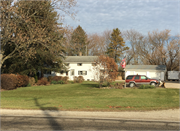Property Record
5317 S COLONY AVE (US HWY 45/MAIN ST)
Architecture and History Inventory
| Historic Name: | |
|---|---|
| Other Name: | |
| Contributing: | |
| Reference Number: | 227235 |
| Location (Address): | 5317 S COLONY AVE (US HWY 45/MAIN ST) |
|---|---|
| County: | Racine |
| City: | Union Grove |
| Township/Village: | |
| Unincorporated Community: | |
| Town: | 3 |
| Range: | 21 |
| Direction: | E |
| Section: | 32 |
| Quarter Section: | SW |
| Quarter/Quarter Section: | SW |
| Year Built: | 1900 |
|---|---|
| Additions: | |
| Survey Date: | 20132019 |
| Historic Use: | house |
| Architectural Style: | Side Gabled |
| Structural System: | |
| Wall Material: | Aluminum/Vinyl Siding |
| Architect: | |
| Other Buildings On Site: | |
| Demolished?: | No |
| Demolished Date: |
| National/State Register Listing Name: | Not listed |
|---|---|
| National Register Listing Date: | |
| State Register Listing Date: |
| Additional Information: | 2019- "This house stands at the northeast corner of Colony Avenue (USH 45) and 1st Street (CTH KR/ County Line Road). It is set in the SW quarter of Section 32 in Yorkville Township south of the Union Grove village limits. Yorkville Township plat maps indicate the property was homesteaded as early as 1858. At that time, the land was owned by James Russel (sp.) and a house was located near its present location. James Russell was born in England in 1816 and emigrated with his wife Mary Ann Goldsworthy in 1842. They made their way to Kenosha “via the Erie canal and the Great Lakes,” and settled in Paris Township. Russell and his father-in-law invested in “320 acres of land; at that time there were very few settlers; game was abundant; wolves were near neighbors; [and there was] only one house in Union Grove.” Russell was “one of the founders” of the village of Union Grove, and by 1906 had become “one of the most prominent settlers, and probably the oldest resident of the village” (Beers 1906: 445, 447-448). In 1853, Russell became one of the 11 founding members and vice-president of the Union Grove Land Company. These settlers joined to purchase 160 acres of land near present-day Main Street and 13th Avenue in the southeast quarter of Section 30, Yorkville Township. The 24-block village was surveyed and platted in 1856. Historical accounts indicate that following his wife’s death in 1865, Russell sold his farm in 1868 and moved to Union Grove where he had “a comfortable home,” but the 1870 US Census lists Russell as a farmer, residing with two daughters in Paris Township (Western Historical Co 1879: 656). The 1880 census lists Russell in Yorkville Township, but not in Union Grove. At the time, he resided with his daughter and son-in-law, Susie and John Drury. They still lived together but inside village limits in the 1900 census, at which time Russell was 83 years old. The village population in 1900 was 520 people, and grew to 616 by the end of the decade (RacineHistory.com 2000). In 1873, the parcel had increased to 132 acres, and a cemetery and second house were located on the same property north of the main house. The land was owned by G. Hulett in 1873 and his estate in 1899. In an 1879 county history, Garn Hulett was identified as a warden of the local Masons society. He was junior warden in 1865 when the Union Grove lodge was organized (Western Historical Society 1879: 481). A relative, C.S. Hulett was owner from at least 1899 to 1915, and again for a time around 1934. The original house in the southwest corner of the parcel was not indicated in 1899; a house again depicted in 1915 in the same location as the original. In the 1880 Federal Census, Chester S. Hulett was 25 and lived with his mother Mary in Yorkville Township. By 1906, Chester had married Jennie Barrows (Beers 1906: 127). Aside from a passing mention, historical and biographical records of prominent Racine County residents published between 1879 and 1916 did not feature Garn or Chester S. Hulett. In 1924, the parcel had been split in two; the resulting property was 87.75 acres and only contained the southern house. It was owned by Albert Minton, about whom no historical biographical information has been revealed. The 1934 map shows the 132-acre parcel intact and once again owned by C.S. Hulett." "The two-story Colonial Revival style house has a cross-gabled roof. The side-gabled front of the house contains the symmetrical façade (west elevation) is comprised of three bays: the central entrance has a tall decorative wood surround (not original) with a flat arch pediment above the door. A concrete stoop with wrought iron railing leads to the doorway, which is solid wood. Both floors of the outer bays contain a single two-over-two sash window. A shorter, longer two-story gabled portion projects off the rear of the house and an interior brick chimney. The south-facing elevation is not symmetrical: two tall sash windows flank the side entrance, offset from a pair of short sash windows. The second floor windows are small and set flush with the roofline at the top of the wall. Windows throughout the house have decorative wood shutters. Most of the sash frames appear to be replacement. The walls are clad in aluminum lap siding the roof has asphalt shingles. A large garage is set behind the house; aerial photographs indicate it was built sometime after 1976." "The property was evaluated for its significance within the statewide agricultural context. Its period of significance begins in 1858, when its first owner can first be determined, until 1934 when it can last be confirmed that longtime owner C.S. Hulett still owned the property. The property is generally associated with development of small towns in rural agricultural areas in the mid-nineteenth century, but research has not revealed associations to specific events or historic trends related to farming or the establishment of the village of Union Grove. Although one of the founders of the village of Union Grove owned the property for a time around 1858, there is no evidence the property is associated with the activities of the Union Grove Land Company when founding the village in the 1850s. Furthermore, the present house was constructed well after that period. The property does not hold associations with events important in local, state, or federal history, and therefore not eligible under Criterion A. An early settler in the area, James Russell, owned this property as early as 1858, however various conflicting historic records do not clarify if he resided here, or where he lived once he moved to Union Grove from his original farmstead. Biographical accounts indicate Russell had been a prominent farmer in Paris Township since settling there in 1842. In 1853, he became vice-president and a founding member of the Union Grove Land Company, which purchased land and platted the village of Union Grove in 1856. Despite his associations to the new village, records indicate he continued residing on his farm for some time. While some accounts note he sold his farm and moved to Union Grove in 1868, US Census records list as a farmer residing in Paris Township in 1870, and living in Yorkville Township in 1880. Plat maps from 1873 and 1887 show that Russell did not own this property, which stands 0.75 miles south of the original town boundaries. A house is not shown here in the 1899 map, indicating the original house was demolished around the turn of the century and the present building was constructed. There is no evidence James Russell resided at this property during the time he achieved significance, and furthermore, this house postdates the period of his ownership. The property does not hold sufficient associations to James Russell, and does not adequately reflect his importance. Research did not identify significant achievements or individual importance of other residents here between 1873 and 1934, including Garn and Chester Hulett and Albert Minton. The property is not eligible under Criterion B. The house is Colonial Revival in style, but does not embody distinctive characteristics of a significant type, period, or method of construction. It has lost integrity of materials because of replacement windows and aluminum cladding. An architect has not been identified; it is not the work of a master, nor does it possess high artistic value. The house is not eligible under Criterion C. This house is recommended not eligible for listing in the NRHP." 2013- "This 2-story Side Gabled house was constructed c.1900. It is rectangular in plan with aluminum siding and an asphalt-shingled gable roof. The front elevation faces west and is symmetrical in plan with a central door flanked by 2-over-2 windows. The front door is accessed by a concrete stoop and has a decorative wood surround that has been added over an earlier simple wood surround. The second story of the fac;:ade contains two smaller 2-over-2 windows. All windows have decorative shutters." -"USH 45: 18th Ave to STH 50", WisDOT#3200-01-02, Prepared by Gail Klein, (2013). |
|---|---|
| Bibliographic References: | Beers, J.H. & Co. Commemorative Biographical Record of Prominent and Representative Men of Racine and Kenosha Counties, Wisconsin (1906). Chicago: J.H. Beers & Co. Retrieved from https://www.google.com/books/edition/Commemorative_Biographical_Record_of_Pro/XT8VAAAAYAAJ (1/30/20). UW-Parkside Archives & Area Research Center. Plat Maps of Racine and Kenosha Counties, 1858-1934. Retrieved from https://archives.uwp.edu/exhibits/show/plat-maps-racine-kenosha/index (1/30/20). Western Historical Co. History of Racine & Kenosha Counties (1879). Retrieved from https://archive.org/details/historyracinean00cogoog (1/30/20). |
| Wisconsin Architecture and History Inventory, State Historic Preservation Office, Wisconsin Historical Society, Madison, Wisconsin |



